Laila M Montaser1*
1Professor of Clinical Pathology, Chair Stem Cell, Regenerative Medicine, Nanotechnology and Tissue Engineering (SRNT) Research Group, Faculty of Medicine, Menoufia University, Egypt
*Corresponding Author: Laila M Montaser, Professor of Clinical Pathology, Chair Stem Cell, Regenerative Medicine, Nanotechnology and Tissue Engineering (SRNT) Research Group, Faculty of Medicine, Menoufia University, Egypt; Email: [email protected]
Published Date: 30-08-2022
Copyright© 2022 by Montaser LM. All rights reserved. This is an open access article distributed under the terms of the Creative Commons Attribution License, which permits unrestricted use, distribution, and reproduction in any medium, provided the original author and source are credited.
Abstract
The coronavirus is one of our modernistic day’s major universal, human defies. The human brain is planned to prefer the present-day and underrate the future. That triggers it hard to prohibit disasters like pandemics. Numerals of medications are presently under examination for the therapy of COVID-19 illness. Whilst these remedies can ameliorate a patient’s recuperation and existence, these curative methods do not achieve frank repair of the lung injury stroked by this sickness. Stem cell therapies are prominent as novel favorable remedies, which could decline inflammation but as well rejuvenate the lung harm caused by COVID-19. Stem cells extend their immunomodulatory, anti-oxidant and reparative curative impacts that could be useful, single or incorporation with other medicinal factors, in patients with COVID-19. Stem cells can be used to outline this hurt by using their renovated characteristics, which allows them to prospect promoted clinical usefulness contracted to else scrutinize pharmacological therapies. Modern proceeds in regenerative medicine have affirmed the chance to generate applicable and active tissue engineering 3D erects containing spirited cells for tissue reform and increase. 3D bioprinting has protruded as a hopeful novel tactic for making compound biological rears in the domain of tissue engineering and regenerative medicine. It targets to lessen the hurdles of imitative tissue engineering procedures by exact and planned layer-by-layer congregation of biomaterials in a required 3D modality. Cell printing aims to transport energetic cells in a 3D style to represent stem cell niches and pathological tissue morphologies for drug examination, or to imitate human tissue confusion acting as biologically pertinent subrogates. A pliable 3D tissue engineering technology authorizes stem cells created from a person’s possess body to split after printing and distinguish in a track to compose and substitute any tissue kind of the body. 3D printing technicalities can distinguish stem cells into lung cells. 3D printing can be utilized to overcome the individual defensive tool lack caused by the new COVID-19 and likewise to employ the technology to originate specimens of human organs and tissues for trials objectives.
Keywords
3D Bio Printing; Tissue Engineering; Cataclysm; COVID-19; Stem Cell; Regenerative Medicine
Introduction
Schematic of 3D bioprinting of lungs symbolized in Fig. 1.

Figure 1: Schematic of 3D bioprinting of lungs.
Bioprinting process consists of: i) patient biopsy to obtain autologous cells, ii) in-vitro cell maturation, iii) cell encapsulation within the biomaterial to realise the bio-ink, iv) 3D printing of the construct, v) incubation and maturation of the 3D biological construct, vi) implant on the human.
Kabir and colleagues reported that through the latest scarce decades, the globe has evidenced various viral epidemics, the present COVID-19 crisis being the most serious and destructive one, demanding millions of lives globally [1]. Physicians, scientists and engineers universally have fused in transacting with the contemporary situation at a magnificent rapidity and effectiveness. 3D bioprinting is emerging as a promised technology for manufacturing congregation tissue structures with sewed biological compounds and mechanistic features. Neoteric improvements have qualified scientists to exactly status substances and cells to construct effective tissue examples for in-vitro drug testing and disease modeling. In every domain of liver, heart, vascular structure and cancer, investigators have harnessed this technology to establish tissue patterns with organ-definite tasks, drug screening implementations and transplantation prospects. Kabir and colleagues 2021 proclaimed that mends in 3D bioprinting have conquered up an entire novel zone to search and use the technology in manufacturing types of the tissues and organs, symbolizing in-vivo milieus. These biomimetic styles can not only be used in discovering the contagion paths and medication toxicology researches but also reduces the necessity for animal paradigms and limit the time bezel for human clinical tests.
Laila M Montaser explained that up-to date advancements in regenerative medicine have affirmed the chance to produce operable and valid tissue engineering 3D designs including living cells for tissue mend and enhancement [2]. 3D bioprinting has appeared as a hopeful novel technique for producing complicated biological frames in the domain of tissue engineering and regenerative medicine. It targets to ease the hurdles of ordinary tissue engineering procedures by exact and monitored sheet-by-sheet assemblage of biomaterials in a wanted 3D platform. Laila M Montaser 2021 declared that cell printing targets to offer vital cells in a 3D style to sum up stem cell slots and pathological tissue frames for drug testing, or to imitate human tissue intricacy serving as biologically applicable surrogates. An adaptable 3D tissue engineering skill enables stem cells triggered from an individual’s own body to cleave after printing and differentiate in a method to format and surrogate any tissue type of the body. 3D printing can be harnessed to address the private safeguarding material scarcity caused by the COVID-19 and also to apply the approach to formulate models of human organs and tissues for examining aims.
Laila M Montaser advertised that patients with organ failure frequently suffer from raised morbidity and lowered goodness of life as present strategies of curing organ failure have restrictions, as well as lack of granter organs, low capacity of inoculations and immunological issues [3]. So 3D printing is evolving as a potent agent for tissue engineering by enabling 3D cell culture within multiplex 3D biomimetic architectures. Bio printing is an eliciting instrument for distinguishing stem cells in 3D patterns. Prof. Montaser 2022 ruled that the harnesses of favorable bio-materials with its cross-linking advantage on supplement of a cross linker grants the idealistic building with which we can cultivate stem cells into a definite tissue or organ. 3D printing arts can distinguish stem cells into lung cells. With this promptness of improvement of science and clinical forward in the employ of 3D bioprinting, stem cells as a cell therapy for serious pneumonia that way could conquer an unprecedented epoch of COVID-19 remedy.
Laila M Montaser documented that the modern advancement of 3D printing technology enables the facilities of evolving bio functional complicated tissue surrogates via manufacturing of cell(s), biomaterial(s) and bioactive compound(s) in accuracy [4]. Progress in 3D printing techniques authorize the feasibility of creating vital human tissues in the lab, aiming to exhibit constructional and operational analogies as aboriginal tissue in the human body. Organoids are stem/progenitor cell-derived self-organized 3D culture in-vitro and pattern the physiological situations of native organs that can show the prospect to form progression and diseases and achieve drug testing to speed up drug breakthrough. As the hurry, certainty, security and property of 3D printers upgrade and the price decreases, 3D printers could act as a major task in this digital transformation of industry. Montaser 2021 proclaimed that the proper utilization of digital health assumes the next proportions into regard: health progress and disease avoidance, patient security, moralities, interworking, intellectual property, data safety (secrecy, probity and accessibility), confidentiality, price-productiveness, patient involvement and accessibility. It should be people-focused, confidence-based, proof-based, actual, competent, sustainably, comprehensive, fair and replaced. The tactical and ground-breaking utilization of digital and state-of-the-art data and contacts technologies will be a fundamental supportive element in relation to assuring that billions more people avail from global health insurance, preferably guarded from health emergencies and realize more appropriate health and well-being.
Laila M Montaser stated that the objective is to apply 3D printing technology to overcome the disadvantages of traditional fabrication methods [5]. 3D printing technologies Use Computer-Aided Design (CAD) and Computer-Aided Manufacturing (CAM) to assist in design and fabrication, so the 3D scaffolds can be fabricated as designed and standardized. Particularly, nanofabrication technology based controlled electrospinning can generate structures with submicron resolution. 3D printing technology by electrospinning technology has been developed. Electrospinning can fabricate constructs to submicron precision. Use of these methods could yield precise 3D scaffolds that mimic the organization of the extracellular matrix and their characteristics could help to study unknown cellular behaviors including adhesion, proliferation and differentiation. This 3D printing technology could be widely used in regeneration of tissues such as bone, cartilage, ligament, muscle, skin and neurons and of organs such as trachea, lung, liver, kidney and heart. Combinations of 3D Nano printing technology with methods from molecular biology and cell dynamics could advance new possibilities for improved tissue regeneration. As long as the interaction between cells and scaffold systems with biomolecules can be understood and controlled and on the understanding that an optimal 3D environment for tissue regeneration can be realized, 3D Nano printing will become an important tool in tissue engineering in the near future.
Laila M Montaser gained twenty nine honorable Certificates of Appreciation from successfully showing a chain of forty five admired global conferences online 29/45 (64.2%) amid the time of COVID-19. The Certificates were awarded in appreciation of an eminent University Professor, World-renowned scientific skipper and a globally accredited researcher with frontier experience for her dedicated and energetic efforts to educate scientific society and public probe on the COVID-19 pandemic. Her track wisdom may open up a novel epoch 3D Bioprinting technology research [6-7].
The next four figures as selected specimens pertain to the Certificates of Appreciation for keynote and invited presentations about the state of art invention and creativeness in 3D Bioprinting technology and applications in regenerative medicine and tissue engineering were awarded to Prof. Laila M. Montaser, that Fig. 2 is a Certificate of Gratitude and Congratulations awarded to her for her video presentation with Chinese translation in the exceptional effort titled “Application of 3D bioprinting for tissue engineering amidst the COVID-19 crisis” offered at BIT’s 14th Regenerative Medicine and Stem Cells 2021, Sept 25-27, Dalian, China, also, Fig. 3 is a Certificate of Recognition awarded to her for her phenomenal and worthy oral keynote presentation on “3D printing technology application for tissue engineering” showed at 2nd International Conference on 3D Printing and Additive Manufacturing 2022, March 25-26, Berlin, Germany, while Fig. 4 is a Certificate of Appreciation awarded to her in recognition of her support of sharing her knowledge as a keynote speaker on “3D printing technology as the digital transformation innovation for digital health sustainable strategies” at 1st International Conference on Digital Transformation 2021, Sept 16-17, Dares Salam, Tanzania and lastly Fig. 5 is a Certificate of Recognition awarded to her for her remarkable keynote presentation on “Nano imprinting of 3D cell culture scaffolds for tissue engineering applications” at 4th International Webinar on Materials Science and Engineering held during Nov 08-09, 2021.

Figure 2: Certificate of Gratitude and Congratulations awarded to Prof. Laila M Montaser at BIT’s 14th Regenerative Medicine and Stem Cells 2021, Sept 25-27, Dalian, China.

Figure 3: Certificate of Recognition awarded to Prof. Laila M Montaser at 2nd International Conference on 3D Printing and Additive Manufacturing 2022, March 25-26, Berlin, Germany

Figure 4: Certificate of Appreciation awarded to Prof. Laila Montaser at 1st International Conference on Digital Transformation 2021, Sept 16-17, Dares Salam, Tanzania.

Figure 5: Certificate of Recognition awarded to Prof. Laila M Montaser at 4th International Webinar on Materials Science and Engineering held during Nov 08-09, 2021.
My opinions harmonized with Campbell et al [8] that crucial standpoint commanders suppose that the new COVID-19 may drive to prolonged lung harm, furthermore triggering the requirement for regenerative therapies. Modern strategies for regenerative cell-based treatments use the segregation ability of human MSCs for searching lung disease pathogenesis and therapy [9,10]. Interestingly, biomaterials are a cell culture stage that can be exactly layout to guide stem cell discrimination [11,12]. Also, Campbell and colleagues reported that the COVID-19 pandemic has supplied clinical facts displaying fibrosis of lung in these patients that remain alive after the contagion [8]. It is speculated that this fibrotic reaction will not retract, leading to a concealed flourishing of chronic pulmonary disease later on. They imagine that the resolution stays at the crossroad of patient-derived stem cells and tissue-informed biomaterials. By engineering biomaterials that can imitate human tissue, we can lead patient stem cells in segregation across rejuvenation of healthy pulmonary tissue or disease epitomes for researching accurate medical therapies. Apart from this, they civilized a nearer glimpse at the most recent of stem cell discrimination for lung engineering, exhibited proof boosting the force of biomaterials to progress stem cell segregation and debated their viewpoint on the potency for tissue-informed biomaterials to mutate lung regenerative medicine.
Hagen and team illustrated that assumed the Coronavirus is influencing the preponderance of the globe and it continues unbeknown how long the virus will persist, novel innovations to make special defensive tools to safeguard frontline healthcare employees were required to beat the insufficiencies of stocks that utilize classical formats of industrializing [13]. Moreover, 3D printing is sure to be one solution presently utilized in the medical domain to cope defies in surgery and prosthetics due to their ease of making and reliability. Long-term effectiveness of COVID-19, inclusive cardiovascular and pulmonary problems, are becoming extra notable in research, displaying a necessity for additional long-term care of those infected with the virus. Too, 3D modelling can be utilized in heart and pulmonary surgeries as samples for scheming and practicing complicated surgeries, 3D bioprinting alteration heart and pulmonary tissues and post-surgical assessments. The 3D printed equipment are as well-being exercised to search the direct impacts Coronavirus, vaccines and medications have on those organs. Otherwise, 3D printing has been harnessed to make face guards, PAPR masks and respirators, which all have the prospect to be employed in the future for healthcare with prosperity and lack the shortage of make available of Private Preventive Equipment (PPE).
Mahfouzi and colleagues announced that tissue transplantation is the solely therapy alternative for patients with end-stage pulmonary diseases; though, this choice experiences from problems like scarcity of granter organs and dangerous transplant-linked hazards, plus blood clots, contagions and refusal of novel implants [14]. Pulmonary and tracheal tissue engineering by 3D bioprinting is a hopeful technique to handle those restrictions with the extreme destination of creating implantable pulmonary and tracheal masons. MSCs have manifested the power to hasten the new-cartilage, new-vasculature and new-epithelium figuration in bioprinted tracheas or engineered lungs. Beside, autologous MSCs do not have the prospect of immune disapproval and turn off the moral wrecks that emerge from the use of embryonic stem cells. So, MSCs are an idealistic cell exporter for bioprinting lungs and trachea.
Irvine and colleagues mentioned that the choice of stem cell origin, bioprinting manner, scaffold chosen, collectives applied and self-acting vigor for implementation can choose stem cell segregation to an appointed purpose tissue [15]. More services in employing stem cells in bioprinting involve their strength to motivate immune magnanimity and broaden the moment that is integrated inside aim tissue.
Zhang and colleagues stated that the area of regenerative medicine has advanced quite the former few decades in its capacity to produce efficacious tissue offsets [16]. Ordinary ways formed on scaffolding and microengineering is restricted in their power of making tissue structures with exact biomimetic traits. 3D bioprinting technology, furthermore, pledges to dare the diversity between synthetic engineered tissue builds and mother tissues.
Mukesh and team estimated that 3D bioprinting is a forthcoming mechanic to produce tissues and organs out of cyclic configuration of varied biological items, plus biochemicals and biocells, in a carefully planned pattern [17]. 3D bioprinting has earned activity in the creation of 3D effective human builds emulating original tissues/organs. 3D bioprinting can be the simulation to global organ paucities and the growing no willingness to examine recently developed cosmetic, chemical and pharmaceutical outputs on animals, also probably risky tests on humans.
Little and Ftse stated that bioprinting technology could give the chance to produce patient-private tissue for the evolution of precise, goal-oriented and perfectly personified therapies [18]. 3D bioprinting can be the answer to global organ insufficiency and the rising dislike to quiz latest cosmetic, chemical and pharmaceutical outputs on animals. Merging stem cells over with other biomaterials (e.g., polymers, bioactive agents, or biomolecules) to fabricate 3D builds workable is one of the essential matters for 3D bioprinting of biosynthetic organs.
Bishop and team proclaimed that going ahead in 3D printing has boosted practicality toward the creation of effective tissues [19]. Famed as 3D bioprinting, this technology comprises the exact layering of cells, biologic scaffolds and growth factors with the target of originating biosimilar tissue for a diversity of utilizes.
My outlook agreed with the research of Le Blanc and Mougiakakos clarified that the immune replies prompted by the Coronavirus, during the nursery and non-serious phases, seekers the speedy beginning of an appointed adaptive immune restraint to expel the virus and block the proceed to dangerous junctures [10,20]. The eventual cytokine storm is in charge of the acute pulmonary damage directed to acute respiratory distress syndrome seen in COVID 19 patients. Mesenchymal Stem Cells (MSCs) are specified to curb too active immune reactions besides tissue renovation and reform [21]. Also my perspective coincides with that of Rao and team immunomodulatory impact of MSCs could grasp prospects to treat a patient with heavy manifestations of Corona infection due to a dysfunctional adaptive immune arrangement [22]. To examine the harness of MSCs in the therapy of COVID confirmed patients with critical disease, Rao and colleagues have launched a clinical experiment (IMD/CoV/001/2020) to transfer allogeneic MSCs originated from contributed bone marrow or umbilical cord managed through implantation in lung whosoever potential or injected intravenously.
Ma and colleagues mentioned that to apply 3D printed tissue samples to give a personal touch to drug testing and disease paradigm, patient specific cell exporters, inclusive human MSCs from patients, will be the principal hub [23].
Wang declared that 3D organ bioprinting is a fascinating technological region with massive trade earning, which could settle the severe neck issues for allograft transplantation, towering-throughput drug examining and pathological investigation [24]. Combining stem cells straight with different biomaterials (e.g., polymers, bioactive agents, or biomolecules) to inspire 3D buildings effectively is one of the bottom problems for 3D bioprinting of bio factitious organs. 3D organ bioprinting is a modern, top-scale interdisciplinary realm that demands the incorporation of skills of abundant scopes of science and technology, like cell biology, computer, substances, input, chemistry, mechanics, engineering, industrialization and medicine.
Aydin and team concluded that 3D printing is repeatedly utilized in considerable domains like aerospace manufacture, structure, architecture, building, medicine, electricity, car industry, food, textile, fashion industry, healthcare and medical industry [25]. In the healthcare and medical industry, 3D printing technology has fantastic features: i) With 3D printing technology, the normal frame of the skin is outputted at a low price, ii) By printing drugs with 3D printing technology, drug capacity could be raised; bulk lowering, needed doses and careful domination of drugs are supplied, iii) With 3D printing, the mission of organs and tissues can be evolved, exchanged or safeguarded, iv) D printing technology concentrates on making, progressing or protecting the job of the bone or cartilage as an outcome of harm from injury or illness, v) Organ disability that is sourced by incidents, sickness and birth defects can also be printed by 3D printing technology and vi) 3D printing technologies can originate controllable types of cancer tissues and have the capability to quicken large cancer research [26] .
In conclusion, 3D bioprinting is an unrivalled technology. This technology will be developing at an astronomical speed in this decade. Bioprinting can originate living tissue, bone, blood vessels and possibly, total organs for use in medical processes, practice and quizzes. Progresses in together research and technology in the squares of medicine, engineering and biology will be required to resolve the challenges to completely understand the scope of 3D bioprinting in developing superb in-vitro disease paradigms and accurate medicine. A superior perception of the tissue/organ microenvironment, that comprises varied sorts of cells, is insistent to succeed 3D bioprinting. The made-up formation of human skin, tissue and inner organs may register like a futuristic dream but, extremely, a lot of it is occurring quite now, although yet in the precocious phases. In research systems and hospitals around the world, advances in 3D printing and, extra certainly, bioprinting are given novel choices for therapy and scientific research. All right, bioprinting has the scope to be the outlook worthy matter in health care and personalized medicine. Scientists have predicted a widely shining future wherever human body fractions can be easily transplanted utilizing bioprinted organs. In the near future the hole between supply and request of organs will be decreased by aftertime 3D Printers. Proceeding polymer-based multidisciplinary endeavors will earn major advantages in 3D organ bioprinting and will substantially subrogate injured/defected human organs soon. Whereas we’re not there until now, there is no doubt that the recipient of medicine will be robustly different with bioprinting inclusive. Now, 3D Bioprinting is utilized for pharmaceutical evolution and drug effectiveness. Research is again proceeding for bioprinting human organs and it is yet beneath quiz. Ago its onset, 3D bioprinting has formed a fantastic advance for the sake of the target of effective tissue printing. Bioprinting could be tuned to make an essential job in personalized regenerative medicine.
Conflict of Interest
The authors declare that they have no conflicts of interest to disclose.
References
- Kabir A, Datta P, Oh J, Williams A, Ozbolat V, Unutmaz D, et al. 3D Bioprinting for fabrication of tissue models of COVID-19 infection. Essays Biochem. 2021;65(3):503-18.
- Montaser LM. Invited speech; presented video with Chinese translation awarded a Certificate of Appreciation: Application of 3D bioprinting for tissue engineering amidst the COVID-19 crisis. BIT’S 14th Regenerative Medicine and Stem Cells. 2021.
- Montaser LM. Keynote speaker awarded a Certificate of Recognition: 3D printing technology application for tissue engineering. 2nd Int Conf on 3D Printing and Additive Manufacturing 2022, March 25-26, Berlin, Germany.
- Montaser LM. Keynote speaker awarded a Certificate of Appreciation: 3D printing technology as the digital transformation innovation for digital health sustainable strategies. 1st Int Conf on Digital Transformation, 16-17 Sept 2021, Dares Salam, Tanzania.
- Montaser LM. Keynote speaker awarded a Certificate of Recognition: Nano imprinting of 3D cell culture scaffolds for tissue engineering applications. 4th Int Webinar on Biomaterials Science and Engineering. 2021;08-09.
- Montaser LM. Ideal behavioral response to lockdown amidst COVID-19 crisis. Adv Tissue Eng Regen Med Open Access. 2021;7(1):35-8.
- Montaser LM. Unprecedented year story to success. J Reg Med Biol Res. 2021;2(2):1-4.
- Campbell DR, Senger CN, Ryan AL and Magin CM. Engineering tissue-informed biomaterials to advance pulmonary regenerative medicine. Front Med. 2021;8:1-9.
- Montaser LM. In continuously battling COVID-19 with innovative perspectives. J Regen Biol Med. 2021;3(2):1-5.
- Montaser LM. Could putting the mesenchymal stem cells technology into practice be an optimistic therapy for the critically ill COVID 19? J Chem Edu Res Prac. 2020;4(2):1-4.
- Montaser LM. Keynote speaker awarded a Certificate of Appreciation: Innovative outlook for containing COVID-19. Webinar Online 13rd Int Conf on Pharmaceutical Chemistry 22 May 2020, Paris, France. World J Pharmacol Toxicol. 2020;3(2):1-2.
- Montaser LM. Editorial: Could stem cells drive research and entrepreneurship in Egypt? J Embryol and Stem Cell Res. 2022;5(2):1-7.
- Hagen A, Chisling M, House K, Katz T. 3D printing for medical applications: current state of the art and perspectives during the COVID-19 crisis. Surgeries. 2021;2:244-59.
- Mahfouzi SH, Tali SHS, Amoabediny GH. 3D bioprinting for lung and tracheal tissue engineering: Criteria, advances, challenges and future directions. Bioprinting. 2021;21:e00124.
- Irvine SA, Venkatraman SS. Bioprinting and differentiation of stem cells. Molecules. 2016;21(9):1-23.
- Zhang YS, Yue K, Aleman J, Mollazadeh K. 3D bioprinting for tissue and organ fabrication. Ann Biomed Eng. 2017;45(1):148-63.
- Mukesh AG, Meher K, Gulati Kh, Poluri KM. Fabrication of biopolymer-based organs and tissues using 3D bioprinting. Nanomedicine. 2019:43-62.
- Little M and Ftse GWF. Printing the future: 3D bioprinters and their uses. 2021.
- Bishop ES, Mostafa S, Pakvasa M, Luu HH, Lee MJ, Wolf JM, et al. 3D bioprinting technologies in tissue engineering and regenerative medicine: Current and future trends. Genes Dis. 2017;4(4):185-95.
- Le Blanc K, Mougiakakos D. Multipotent mesenchymal stromal cells and the innate immune system. Nat Rev Immunol. 2012;12:383-96.
- Montaser LM. Could stem cell study in space avail patients and researchers on Earth? Adv Tissue Eng Regen Med Open Access. 2022;8(1):1-5.
- Rao V, Thakur SH, Rao J, Arakeri G, Brennan PA, Jadhav S, et al. Mesenchymal stem cells-bridge catalyst between innate and adaptive immunity in COVID 19. Med Hypotheses. 2020;143:109845.
- Ma X, Liu J, Zhu W, Tang M, Lawrence N, Yu C, et al. 3D bioprinting of functional tissue models for personalized drug screening and in-vitro disease modeling. Adv Drug Deliv Rev. 2018;132:235-51.
- Wang X. Advanced polymers for three-dimensional (3D) organ bioprinting. Micromachines. 2019;814(10): 1-25.
- Aydin A, Demirtas Z, Ok M, Erkus H, Cebi G, Uysal E, et al. 3D printing in the battle against COVID-19. Emergent Mater. 2021;8:1-24.
- Shahrubudin N, Lee TC, Ramlan R. An overview on 3D printing technology: technological, materials and applications. Procedia Manufactur. 2019;35:1286-96.
Article Type
Commentary Article
Publication History
Received Date: 09-08-2022
Accepted Date: 23-08-2022
Published Date: 30-08-2022
Copyright© 2022 by Montaser LM. All rights reserved. This is an open access article distributed under the terms of the Creative Commons Attribution License, which permits unrestricted use, distribution, and reproduction in any medium, provided the original author and source are credited.
Citation: Montaser LM. 3D Bioprinting for Tissue Engineering Amidst the Century Cataclysm. J Reg Med Biol Res. 2022;3(2):1-12.
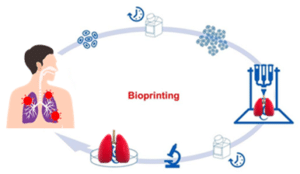
Figure 1: Schematic of 3D bioprinting of lungs.
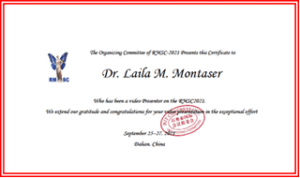
Figure 2: Certificate of Gratitude and Congratulations awarded to Prof. Laila M Montaser at BIT’s 14th Regenerative Medicine and Stem Cells 2021, Sept 25-27, Dalian, China.
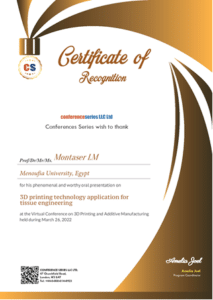
Figure 3: Certificate of Recognition awarded to Prof. Laila M Montaser at 2nd International Conference on 3D Printing and Additive Manufacturing 2022, March 25-26, Berlin, Germany
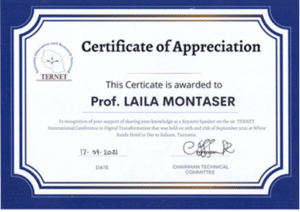
Figure 4: Certificate of Appreciation awarded to Prof. Laila Montaser at 1st International Conference on Digital Transformation 2021, Sept 16-17, Dares Salam, Tanzania.
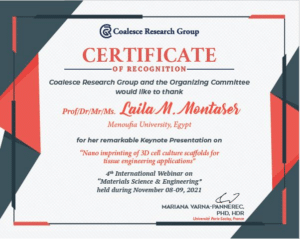
Figure 5: Certificate of Recognition awarded to Prof. Laila M Montaser at 4th International Webinar on Materials Science and Engineering held during Nov 08-09, 2021.


